Guides
The pandemic reinforced just how powerful the simple act of giving can be. These are a few of our favorite causes.

A group of women veterans after a class on horticultural therapy at the Veterans Multi-Service Center’s Women Veterans Center. / Photograph by Scott Lewis
Veteran services
The Veterans Multi-Service Center
What It Does – Serves those who served
Budget – $12.7M
Founded – 1980
Too many Vietnam War veterans discovered themselves in a new war when they returned stateside and were treated with scorn. The Veterans Multi-Service Center was founded as one of 23 national programs designed to meet the needs of Vietnam veterans and has since grown to serve all veterans. Homelessness, hunger, incarceration, mental illness, drug abuse and unemployment are all problems that plague veterans; the Veterans Multi-Service Center is the only nonprofit organization in the Philadelphia region offering comprehensive services to help them get back on track. Get involved: vmcenter.org.
Maternal care
What It Does – Supports parents impacted by racial and social inequities
Budget – $12.8M
Founded – 1980
Last year, 130 Philadelphia babies died before reaching their first birthdays. The city has one of the highest infant mortality rates in the nation, and it’s the mission of the Maternity Care Coalition to correct that by serving pregnant and postpartum women and families in underserved communities. Staff and volunteers offer home visits, prenatal care, parenting and life-skills education, school readiness support, and referrals to medical care; they also serve as empathetic cheerleaders for a family’s healthy start. Get involved: maternitycarecoalition.org.
Food insecurity
What It Does – Uses food to change lives
Budget – $3.3M
Founded – 1976
Cathedral Kitchen started when a group of four young idealists heard an inspirational talk from Mother Teresa at the 41st International Eucharistic Congress in Philadelphia and decided to feed the hungry in Camden. Fast-forward 45 years, and that seed has produced a nonprofit organization that serves 100,000 meals a year, making it the largest meal provider in the city of Camden. Its tagline: “Using food to change lives.” That’s why Cathedral Kitchen offers a free culinary-arts training program. Its social enterprise businesses include an entrepreneurial venture that provides contract meals for local shelters and halfway houses, catering, and a weekly CK Café pop-up dinner bundle available for pickup. More importantly, Cathedral Kitchen practices radical hospitality, with all comers treated with dignity regardless of their economic status. Get involved: cathedralkitchen.org.
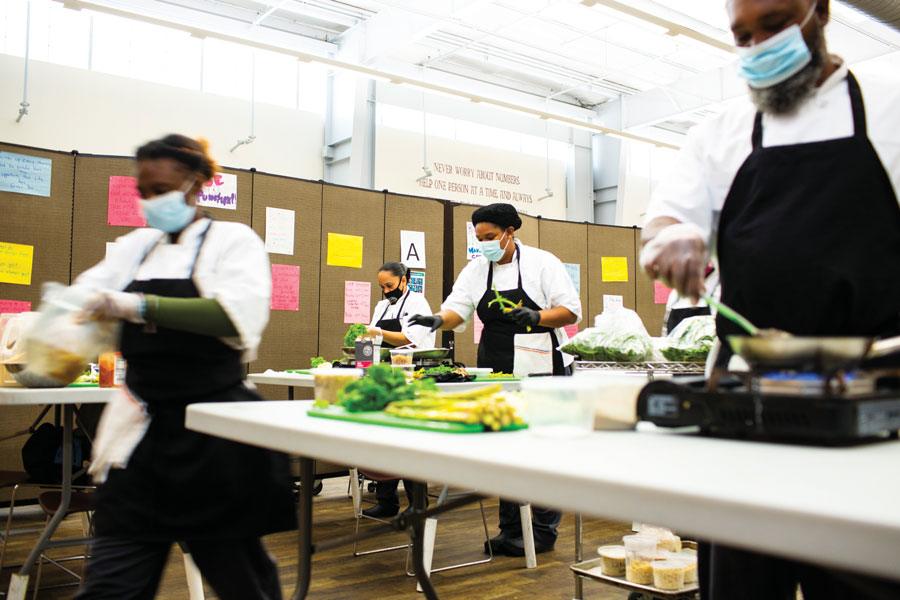
Students prepare a dish from a “mystery box” cooking lesson using a variety of fresh produce and grains at Cathedral Kitchen in Camden. / Photograph by Scott Lewis
What It Does – Feeds the hungry
Budget – $1.6M
Founded – 2000
When he was a 20-something, Marc Erlbaum told his rabbi that he wanted to undertake a relief mission to help the poor overseas. The wise rabbi pushed back: “What about all the poor Jews right here in Philadelphia?” Inspired by that conversation, Erlbaum co-founded the Jewish Relief Agency, a leader in home-delivered hunger-relief programs. JRA provides a monthly free kosher food box and essential household items to 3,800 food-insecure households in the region. For the elderly, the disabled, Holocaust survivors, and those who lack transportation, delivery makes a considerable difference to their quality of life. JRA’s hundreds of volunteers make that delivery possible. Get involved: jewishrelief.org.
What It Does – Feeds the medically vulnerable
Budget – $7.6M
Founded – 1990
“Food is medicine” — that’s MANNA’s mantra. In 1990, seven members of the First Presbyterian Church of Philadelphia began delivering meals to neighbors who were dying of AIDS; since then, MANNA has served clients afflicted by more than 85 different illnesses, becoming a leader in providing medically appropriate meals for those with such diseases as cancer, renal disease and HIV/AIDS. Since 2006, MANNA has served anyone whose critical illness poses an acute nutritional risk. Get involved: mannapa.org.
Education
What It Does – Educates and advocates for students in child welfare and juvenile justice systems
Budget – $1.9M
Founded – 2015
C.B. Community Schools is a small private high school in Roxborough with a hefty annual tuition fee. That’s a time-tested recipe for an elite education, except the student body at C.B. Community Schools consists of foster children aging out of the child welfare system, and all attend on full paid scholarships. About 40 percent of C.B. youth have become entangled in the juvenile justice system; all have attended three or more high schools, and almost 60 percent have been in institutionalized placement. Yet the school has a 90 percent graduation rate, and 100 percent of its graduates connect to post-secondary opportunities. The reason: In addition to the 3Rs, C.B. offers socio-emotional support throughout the program to help students deal with their anger, depression and self-sabotage. Get involved: cbcommunityschools.org.
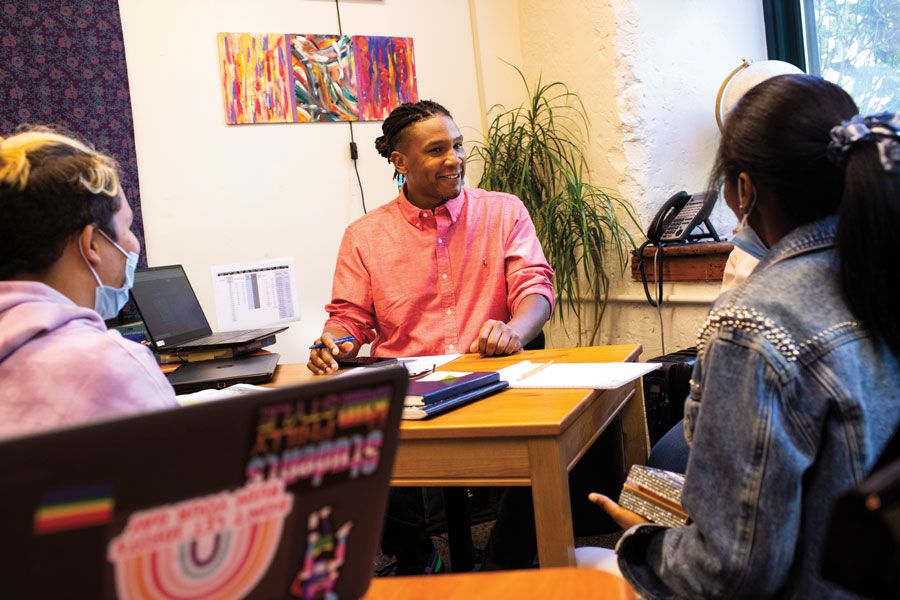
C.B. Community history teacher Steven Brown listens to some students as they prepare an original poem for a presentation for Latin Heritage Month. / Photograph by Scott Lewis
What It Does – Crowdsources for Philly schools
Founded – 2017
The Alexander K. McClure school needed $561 for its Girls on the Run program. The Tanner G. Duckrey school wanted $471 for butterfly kits. Both turned to Philly FUNDamentals, a crowdsource fund-raising program run by the Fund for the School District of Philadelphia. Philly FUNDamentals allows any donor (listen up, school-district alums!) to give directly to a school’s needs. The asks range in size from small to significant. To date, Overbrook Educational Center’s playground has been the highest-funded project, at $175,000, but most requests range from $1,500 to $5,000. Get involved: thefundsdp.org.
Reentry
What It Does – Helps formerly incarcerated women
Budget – $627,000
Founded – 2001
How would you fare if you exited prison and needed to restart your life? The first thing you’d learn is that in Pennsylvania, there are 500 different legal and regulatory consequences to a criminal conviction, including employment and housing barriers, penalties and fines. Little wonder that nearly 60 percent of women who are released from prison will be rearrested. As a formerly incarcerated person who once experienced addiction, Michelle Anne Simmons understands this on a personal level. She has poured the lessons she learned in rebuilding her own life into Why Not Prosper, a grassroots nonprofit that provides a menu of services to help women stay out of jail, including help with finding employment, securing transitional housing, and reuniting with their children. Why Not Prosper’s goal: for formerly incarcerated women to become economically self-sufficient and contributing members of society. Get involved: why-not-prosper.org.
Community development
United Way of Greater Philadelphia and Southern New Jersey
What It Does – The original community chest
Budget – $61.4M
Founded – 1921
Philadelphia is the country’s poorest big city, and the United Way of Greater Philadelphia and Southern New Jersey has retooled itself to focus on alleviating that poverty. Celebrating a century of good deeds this year, the United Way has been a stalwart of the region’s philanthropic community. But the organization’s focus today is squarely on building a more equitable and prosperous city, even as it continues its traditional responses to crises like COVID-19 and Hurricane Ida. Get involved: unitedforimpact.org.
Neighborhood development
What It Does – Supports the Latino community
Budget – $40M founded
Founded – 1986
How do you help Latino families succeed when they believe the public education system, the very foundation of that success, is failing their children? That’s the concern that pushed Luis Cortés Jr. to create Esperanza, a faith-based nonprofit designed to strengthen the Latino community. Cortés took the Biblical imperative to serve the least of these literally; today, Esperanza provides 25,000 families each year with a smorgasbord of programs that includes arts, community development, immigration and legal services. Esperanza’s chief function is still education, though, and it runs a charter school, a cyber charter school and a college to that end. Cortés says that when you help people to the point that they can say “I can” — that’s the transformational moment that changes everything. Get involved: esperanza.us.
Community center
Charles A. Melton Arts & Education Center
What It Does – Provides programs for the marginalized
Budget – $520,000
Founded – 1918
Equity and inclusion have been at the heart of the Charles A. Melton Arts & Education Center since its beginnings, when it was founded to help the marginalized in the greater West Chester area. The center delivers a range of programming, including the Filet of Soul Culinary Program, which prepares and distributes meals to needy families in Coatesville and West Chester. It offers tutoring for students and help for parents challenged by remote instruction and is in partnership to build 51 new affordable apartments and townhouses, providing much-needed housing for lower-income workers. The connecting thread for all the Melton Center does is its focus on the least, the last, the left-out and the left behind. Get involved: meltoncenter.org.
Environment
Chester Residents Concerned for Quality Living
What It Does – Fights environmental racism
Budget – $50,000
Founded – 1992
The city of Chester has become our region’s trash can. An incinerator in this city of 34,000 can burn up to 3,500 tons of trash daily, and only 1.6 percent of that waste is from the residents. The rest comes from Delaware County, New York City, New Jersey and Philadelphia. But residents suffer in the form of health burdens and declining property values. Communities of color are most often home to facilities that have the greatest negative impact on the environment, and grassroots groups like Chester Residents Concerned for Quality Living have had to fight for years for the right to breathe. Get involved: chesterresidents.org.

Zulene Mayfield founded Chester Residents Concerned for Quality Living in 1992. / Photograph by Scott Lewis
Information and literacy
Friends of the Free Library of Philadelphia
What It Does – More than just books
Budget – Varies*
Founded –1973
The Philadelphia Free Library has its own foundation, but the neighborhood branches get by with a little help from their friends. The Friends of the Free Library is an independent nonprofit organization that supports library groups and is totally dedicated to the city’s 54-branch library system — one of the most extensive in the country. Active volunteer Friends groups provide additional support to their local librarians, helping to enrich programming, boost services, and improve the collection. Get involved: Stop in your local library branch.
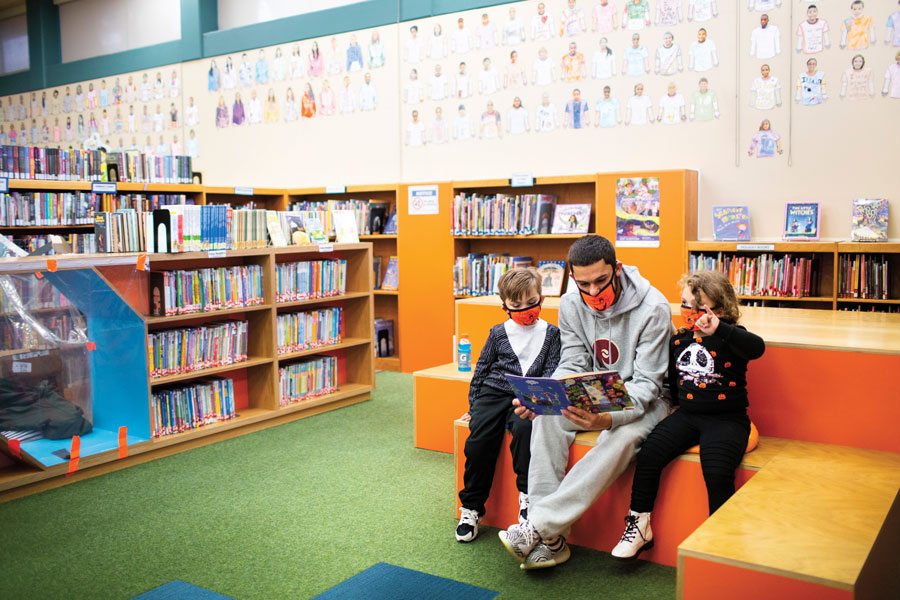
Greg Marshall reads to his children, Gino, five, and Millie, four, at a Friends of the Whitman Branch of the Free Library of Philadelphia Halloween event. / Photograph by Scott Lewis
Homelessness
What It Does – Houses the chronically homeless
Budget – $37.1M
Founded – 1989
Philadelphia has one of the highest rates of poverty of any large U.S. city but has a relatively low rate of those experiencing street homelessness. That’s due in part to the work of Project HOME. “None of us are home until all of us are home” is Project HOME’s famous motto, and getting all of us home will require finding affordable housing for more than 5,600 people who will be without shelter this winter. Sister Mary Scullion, co-founder of Project HOME, has advocated for more than 30 years that housing is not only a basic human right but also leads to better health, educational and financial outcomes. As she once proclaimed, “There’s something radically wrong in our society if anybody is living on our streets.” Get involved: projecthome.org.
QTBIPOC
What It Does – Foments radical social justice
Budget – $425,000
Founded – 1989
Galaei, the city’s only Latino LGBTQ organization, is now opening its service model to all queer, trans and BIPOC residents. Galaei got its start during the HIV/AIDs epidemic to serve Latino men and provides a safe space and support along with services such as sexual health education and counseling. It has also created TINGS (Transgender, Intersex, Non-binary and Gender nonconforming Services), the first entirely for trans, by trans program in the state of Pennsylvania. Galaei is unwavering in its commitment to promoting queer Latino social justice. Get involved: galaeiqtbipoc.org.
Youth development
What It Does – Hacks for good
Budget – $4.4M
Founded – 2000
Hopeworks started as a training program to connect disenfranchised youth to opportunity. But the organization soon discovered that success required much more than providing those youth with chances. Young people also needed trauma-informed services — and these proved to be the ingredient that allows them to take advantage of life-changing opportunities. Now, this nonprofit helps at-risk youth develop tech and entrepreneurship skills, and those it serves in turn help the community with tech issues. Get involved: hopeworks.org.
Immigration
What It Does – Offers help to newcomers
Budget – $7.7M
Founded – 1921
Some 22,000 refugees from Afghanistan will be resettled in the United States, and Philadelphia is one of the cities that will become home. The Nationalities Service Center’s mission is to work with immigrants and help them thrive. To support these latest refugees, the NSC is looking for people to meet them at the airport, make or donate authentic culturally appropriate meals, and help set up housing. The NSC serves about 5,000 immigrants and refugees from more than 120 countries annually, providing comprehensive services in the areas of language and legal help, community integration, access to health care, and job readiness training. Get involved: nscphila.org.
New Sanctuary Movement of Philadelphia
What It Does – Protects refugees
Budget – $386,000
Founded – 2007
Some 170,000 undocumented immigrants live in Pennsylvania, and providing them with a place of refuge is either an act of civil defiance or radical hospitality. New Sanctuary Movement of Philadelphia, an interfaith, multicultural immigration justice organization, calls it a radical welcome. For 14 years, NSM has worked to secure rights for the undocumented — and its latest battle is to allow such residents to get driver’s licenses. During the pandemic, NSM shifted to COVID relief after its research revealed that 60 percent of immigrant families needed free food or were eating and buying less, that half of the households were entirely unemployed, and that 40 percent had only one family member working. Now, NSM wants the immigrant community to emerge from COVID-19 with more organizational power than ever. Get involved: sanctuaryphiladelphia.org.
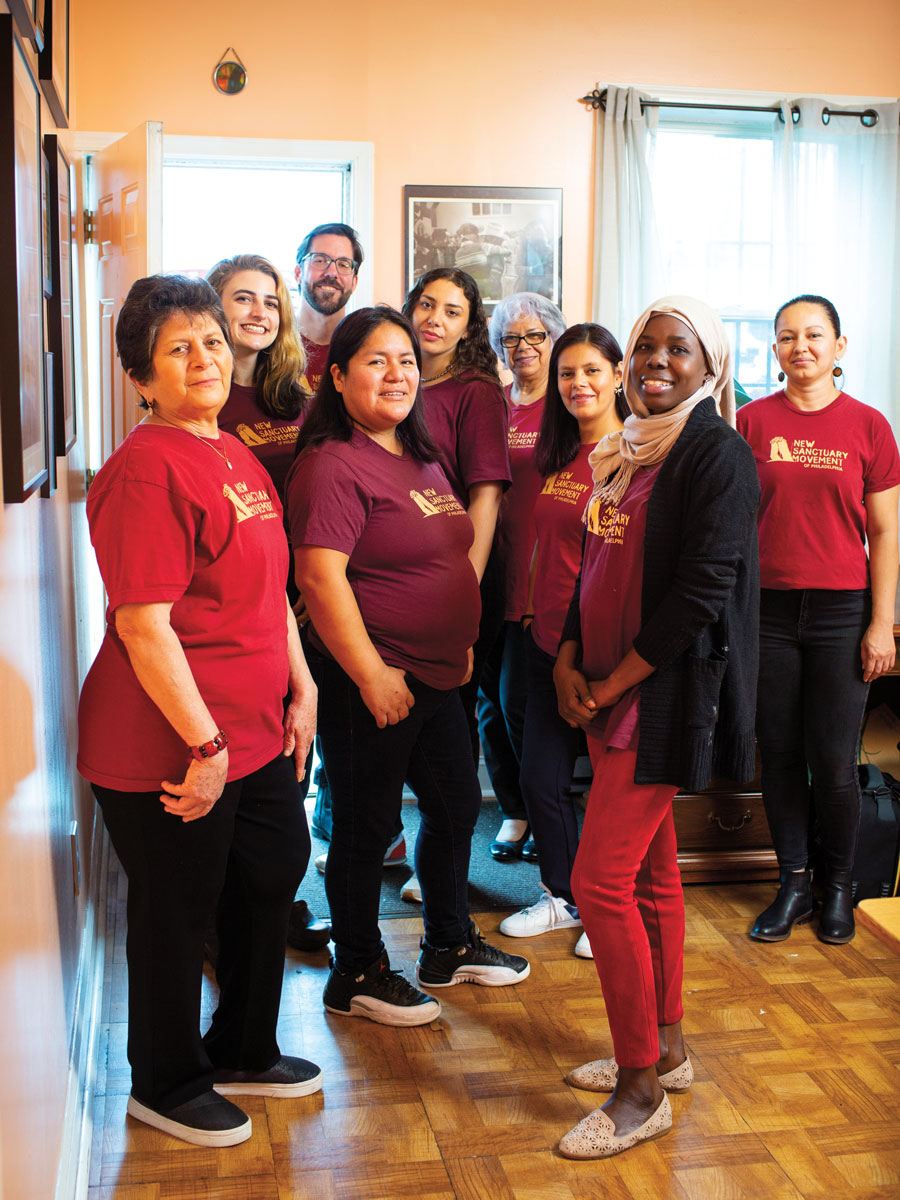
The staff at the New Sanctuary Movement of Philadelphia in their Kensington rowhome office. / Photograph by Scott Lewis
What It Does – Helps the multicultural Asian population
Budget – $3.2M
Founded – 1984
Philadelphia’s Asian American community represents a variety of countries, including Bhutan, Indonesia, Cambodia, Vietnam and Laos as well as China and South Korea. The Southeast Asian Mutual Assistance Association Coalition, better known as SEAMAAC, seeks to help them all. Since 1984, SEAMAAC, the oldest and largest refugee-founded agency in the region, has worked to acclimate thousands of Asian immigrants into the city using a multi- lingual staff that speaks close to 20 languages and dialects. Get involved: seamaac.org.
Benefit access
What It Does – Connects people and funds
Budget – $30M
Founded – 2005
Sixty billion dollars in government benefits go unclaimed annually. (For example, before the pandemic, only 82 percent of eligible individuals and 48 percent of eligible seniors were enrolled in SNAP.) The Benefits Data Trust, a national nonprofit, uses a combination of newfangled technology and old-fashioned enrollment assistance to connect people to the social safety net that provides food, health care and housing. Since 2005, BDT has secured more than $7.5 billion in benefits for households across the country. Get involved: bdtrust.org.
Community advocacy
What It Does – Builds up the Latino community in Montco
Budget – $1.1M
Founded – 1977
About 45,000 Montgomery County residents — five percent of the population — are Latino, and many are underserviced by the county’s safety-net organizations. Nelly Jiménez-Arévalo, ACLAMO’s executive director and a Venezuelan immigrant, says the organization’s role is to remedy that. She ardently advocates for bilingual and bicultural engagement and is working with Montco’s health department and Legal Aid of Southeastern Pennsylvania to ensure more effective outreach. For the past 44 years, ACLAMO has provided education, social services, and health access programming in an attempt to live up to its guiding principle: “We build a stronger community one child and one family at a time.” Get involved: aclamo.org.
Legal services and policy advocates
Community Legal Services of Philadelphia
What It Does – The one-stop shop for free legal help
Budget – $15M
Founded – 1966
More than 11,000 clients a year stream through Community Legal Services’ doors having suffered some debilitating civil pox — an unlawful termination, an eviction, a theft of wages. CLS is expert in dealing with the issues born at the intersection of poverty and law, and its goal is for clients to leave with a sense of relief, empowerment and comfort. But when person after person comes in with the same problem, the public-interest law firm transforms into a policy advocate, fighting for systemic change. It most recently issued reports calling for more attention to the failure of the pandemic response to assist young adults and putting a spotlight on disparity in the rates of COVID-19 among the state’s Black and Latino nursing-home residents. Get involved: clsphila.org.
Community and arts development
The Village of Arts and Humanities
What It Does – Builds community
Budget – $1.6M
Founded – 1989
The Village is driven by a team of artists, designers, entrepreneurs, cultural organizers, and community developers who are working to ensure that Black residents of the Fairhill-Hartranft neighborhood are supported to lead, steward and benefit from neighborhood revitalization. The Village believes that real change is born from within the community itself; its arts-driven work focuses on creating the conditions that enable people to build their own self-efficacy, to learn and build in solidarity with one another, and to design solutions that reflect their own lived experiences. Get involved: villagearts.org.
Addiction
What It Does – Strikes back at opioids
Budget – $14M
Founded – 1992
Before COVID struck, opioid overdoses were being called the city’s greatest public-health crisis in a century. Prevention Point, headquartered in Kensington, is at the epicenter of Philadelphia’s opioid crisis. Its first rule: Reduce harm. That includes arranging for syringe exchanges — which are credited with reducing new HIV infections — and training anyone who will listen on how to use Narcan, the overdose reversal drug. Prevention Point also provides a menu of support services, including case management, medical care, overdose prevention education, and naloxone distribution. Get involved: ppponline.org.
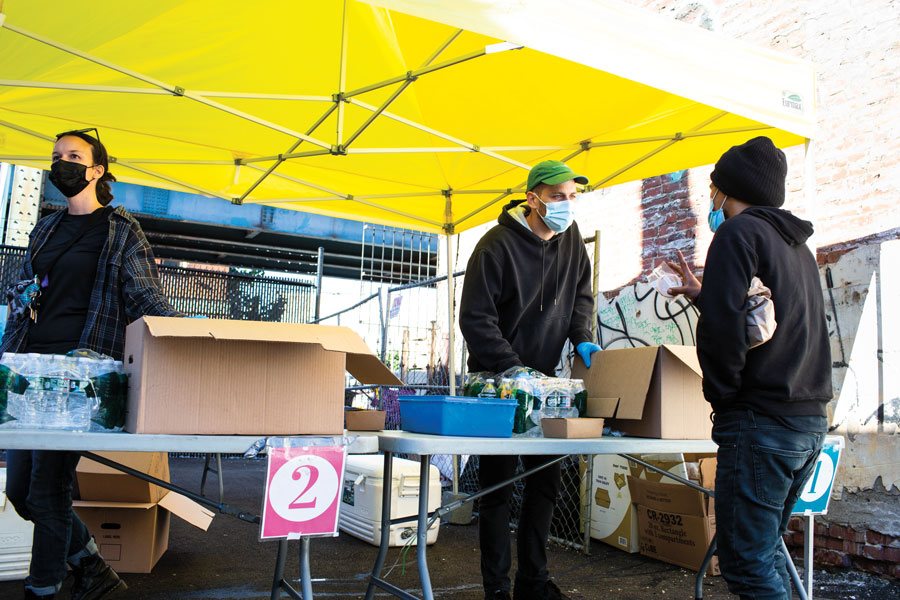
Volunteer and social-work intern Amy Ecklund and volunteer Jason McClintock greet people at a daily meal giveaway at Prevention Point’s main offices in Kensington. / Photograph by Scott Lewis
Senior citizens
What It Does – Promotes active aging
Budget – $2.2M
Founded – 1968
Close to one in four U.S. adults over 65 are socially isolated, which leads to a greater risk of poor health outcomes. Center in the Park, located in Germantown, wants to reframe the role of the traditional senior center into one that supports active aging. Over the past decade and a half, CIP has transformed itself into a wellness center offering social, recreation, health and fitness, arts and humanities, and lifelong learning programs. Fun just may be the true fountain of youth. Get involved: centerintheparkphila.org.
Economic justice
Philadelphia Unemployment Project
What It Does – Stands up for the unemployed and the poor
Budget – $1.1M
Founded – 1975
The Philadelphia Unemployment Project is proof that there’s still political power in citizen participation. Fighting on behalf of the poor, low-wage workers and the unemployed since 1975, PUP is determined to bring economic justice to those who have suffered the most, especially with housing, health and labor issues. PUP is also a frontline service provider, helping low-income people with unemployment compensation, foreclosures, utility payments and SNAP benefits. PUP lives by the notion that you can fight City Hall, but not alone. Get involved: philaup.org.
Higher education
Community Colleges (of Philadelphia, Delaware County, Montgomery County and Camden County)
What They Do – Provide the fuel for economic mobility
Founded – In the ’60s
Once considered higher education’s poor relations, community colleges today are being heralded as forces for economic mobility. Our region is rich in community colleges, all of which stay responsive to employers’ needs and serve non-traditional students. But their student bodies were hard-hit by the COVID crisis, experiencing unemployment, homelessness, lack of childcare and illness. Although community colleges don’t have deep endowment pockets, they maintain a strong commitment to keeping higher education available and affordable. Get involved: bucks.edu, camdencc.edu, ccp.edu, dccc.edu, mc3.edu.
Community organization
What It Does – Makes life better
Budget – $5M
Founded – 1902
Kensington, Port Richmond and Fishtown were once industrial magnets, drawing immigrants from across Eastern Europe who would work in the area’s booming factories. Lutheran Settlement House was part of the settlement-house movement, which developed to help these immigrants acclimate to their new country. Today, LSH is still headquartered in its original location and still reaching out to its neighbors with services to address domestic abuse, homelessness, education and food insecurity. The goal is the same as it was 119 years ago — to help build self-sufficiency. Get involved: lutheransettlement.org.
Housing insecurity
Utilities Emergency Service Fund
What It Does – Helps stabilize housing
Budget – $4.7M
Founded – 1983
Struggling families are often confronted with dilemmas as they face utility shutoffs for non-payment of bills. When the state lifted its moratorium on such shutoffs in April, 116,000 customers lost service. In its first quarter-century, the Utilities Emergency Service Fund had a laser focus on helping low-income Philadelphians with their utility issues — shutoffs, arrearages, or the inability to afford oil heat. Then, in 2009, UESF saw utility shutoffs as an indicator of a larger issue and expanded its focus to helping families stay in their homes. In addition to utility grants, it began to provide security-deposit and mortgage assistance, workshops and counseling. Get involved: uesfacts.org.
What It Does – Gets vulnerable youth off the street
Budget – $29M
Founded – 1973
About 600 to 750 youth face homelessness every night in Philadelphia, and 40 percent of homeless youth in the U.S. are part of the LGBTQ community. Still others were formerly in foster care. All of them are vulnerable. Valley Youth House provides consistent, personalized support, ensuring that housing- insecure young people can pay their rent, get enough food, and have stability in their daily lives. Its Pride Program has been providing housing for LGBTQ+-identified youth between the ages of 18 and 24 since 2008. In February, the city’s Department of Human Services awarded VYH a $1 million contract to provide rapid support and housing assistance to 60 young people who are aging out of the foster- care system. Get Involved: valleyyouthhouse.org.
Published as “The Ultimate Guide to Giving Back” in the December 2021 issue of Philadelphia magazine.
Read how “COVID Turned the Philanthropy World Upside Down” here.
"Give" - Google News
November 28, 2021 at 09:05AM
https://ift.tt/3FKGboK
30 Great Philly Nonprofits to Give to This Year - Philadelphia magazine
"Give" - Google News
https://ift.tt/2YqGX80
https://ift.tt/2YquBwx
Bagikan Berita Ini














0 Response to "30 Great Philly Nonprofits to Give to This Year - Philadelphia magazine"
Post a Comment